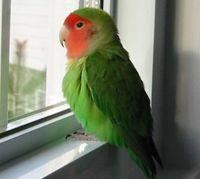Lovebird - Peach Face
Peach Faced Lovebird Scientific Name: Agapornis roseicollis roseicollis
Tue, 15th July, 2025 - 10:05 pm GMT
Sponsor Ads:

Alternative Name
Peach Faced Lovebird Scientific Name: Agapornis roseicollis roseicollisBasic Info
Because the Peach Faced Lovebird is such a popular lovebird species it comes as no surprise that many different color mutations have arisen. Some of the most common include, Creamino, Lutino, Orange Faced, White Faced Blue, Blue Pied Dilute, Fallow, and Cinnamon. In addition many of these mutations can be combined to produce even more colors called mixed mutations. The wild type (light green) Peach Faced Lovebird has green plumage and a peach colored face. The peach color lightens as it approaches the bill and darkness towards the crown. They have blue rumps, gray feet and a horn colored bill. The Peach Faced Lovebirds are classified between the sexually dimorphic group, whose sexes are easily distinguishable by appearance, and the white eye-ring group whose appearance is impossible to define by appearance. In general, the Peach Faced Lovebird does not show any obvious sexual dimorphism. Some breeders will use a pelvic bone test where they examine the tips of the pelvic bone. Male pelvic bones generally feel solid while the females have a space, which is almost large enough to fit a finger. This test is not, however, 100% accurate. There are always exceptions to every rule. The same is true for guessing sex by size. In general females are bigger, but this is not always the case. For accuracy in sexing consult your avian veterinarian to discuss DNA and surgical sexing options. A small parrot, the average adult Peach Faced Lovebird measures 15cm long.
Health
Slight aggression to other birds has been seen in some Peach Faced Lovebirds. Get a very large cage to house this Lovebird in, as they need lots of room to 'spread their wings.' Perches should be a part of the home for these sweet birds, and daily water changes are important. Keep the cage in a place where the family members spend a lot of time. Keep these birds away from Teflon (non-stick material) as it will be deadly to these birds. Peach Faced Lovebirds require a varied healthy diet. An all pellet diet is generally considered too low in fat for a Lovebird. African species require a higher fat content than some other species, so seed should also be included in the diet. Lovebirds should be given fresh vegetables. Favorites include corn, peas, string beans, collard greens, broccoli, shredded carrot and kale. They are also reported to love fruit! As with most parrots, getting a hand raised baby is always suggested. In addition it is important to find a hand trained Peach Face as well. Without hand training, even a hand raised individual can revert back to wild behavior. It is important to have wings trimed regularly as the flight feathers grow in. Lovebirds that have escaped can be very harmful to native wildlife in some regions. For example, escaped lovebirds are detramental to the native woodpeckers in Arizona, USA. Breeding In the wild the Peach Faced Lovebird typically chooses to breed in the nests of another species of bird; the Weaver Bird. In captivity this charming breed, is bred easily. Many claim they are the easiest lovebirds to breed in captivity. Fledglings are fully fledged by six to seven weeks.Habitat
They seem to prefer the dry savannah but do not stay too far away from water.Behavior
The Peach Faced Lovebird is considered by many to be the most popular of all the lovebird species. It is no surprise why when one considers their wonderful personalities and their beautiful appearance. The Peach Faced Lovebird has been described as a large parrot in a little body. It possesses many of the wonderful personality traits of the larger parrots. Many possess the ability to mimic and will imitate noises and whistles. They do not, however possess the great ability to speak like many of the other parrot species. It should not be said that they never speak, in some cases small little squeaky words have been heard coming from a Peach Faced Lovebird - some can even speak short sentences. But this is not the norm, and one should not expect speech from their Peach Faced Lovebird. Like many of the larger parrots they love to climb and will often be seen hanging upside down in their cages. Unlike the larger parrot breeds the Lovebird is very small in comparison and does not require much space, in addition they are not nearly as messy or as noisy. They are communicative and their voices can be heard often, but they are not loud like their larger cousins. With proper care the Peachface Lovebird may live over 20 years, though the average is around 15 years. The Peachface Lovebird may become aggressive to other birds, though individuals will vary.Origin
AfricaHistory
The Peach Faced Lovebird was officially recognized in 1817, but was discovered in the late 1700's. For several years it was considered a subspecies of the Red Faced variety. They were first imported to Europe in the mud 1800's. The Peach Faced Lovebird originates in Africa, and is commonly seen in the southwest regions in large flocks of 20 to 30.Common Foods
They sometimes use their feet to eat, but they do not raise food to their bills like larger parrots.Sponsor Ads:
"Now the general is the bulwark of the State; if the bulwark is complete at all points; the State will be strong; if the bulwark is defective, the State will be weak." -- Sun Tzu, The Art of War
Lovebird - Peach Face
Coded by: BGID® | ALL RIGHTS RESERVED Copyright © 2000-2025
Disclaimer | Privacy | Report Errors / Contact | Credits








 President of the United States of America - Real Estate mogul, Pageant owner and now one of the most controversial men in political history.
President of the United States of America - Real Estate mogul, Pageant owner and now one of the most controversial men in political history.  Global warming has been in and out as the "latest" hot topic for many years. It is, according to modern scientists, the result of man-made industrial pollutants, clearing forested areas, agriculture, etc. But now they are thinking it started way before the Industrial Revolution...
Global warming has been in and out as the "latest" hot topic for many years. It is, according to modern scientists, the result of man-made industrial pollutants, clearing forested areas, agriculture, etc. But now they are thinking it started way before the Industrial Revolution...  Politician, US Vice President and President of the USA - Joseph Robinette Biden Jr.
Politician, US Vice President and President of the USA - Joseph Robinette Biden Jr.  versus
versus  Russia: 'The Evil Empire'? Are they all that bad or is it just the USA trying to portray Russia as bad because they are a world power with land bigger and a society very different from the USA ideal?
Russia: 'The Evil Empire'? Are they all that bad or is it just the USA trying to portray Russia as bad because they are a world power with land bigger and a society very different from the USA ideal? 
 Corona virus
Corona virus 
 Users with wide screen monitors can benefit from more content on every page.
Users with wide screen monitors can benefit from more content on every page.